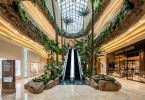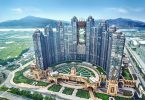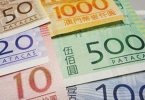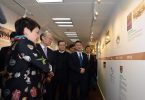This article first appeared in the Jan/Feb 2016 issue of WGM.
Aging quietly nearby the popular tourist spots of the Ruins of St Paul’s and Senado Square are three streets that share an important slice of history as the oldest streets in Macau.
![[b]Nowadays the shops on Big Street are mainly daily consumptions shops[/b]](http://www.wgm8.com/wp-content/uploads/2015/12/images_wgm_1039_macaus-oldest-street-1.jpg)
Taking a look into the history of Macau’s streets, the first name that reveals itself is Rua dos Mercadores, whose Chinese name literally means “Big Street”. Together with the adjacent Rua das Estalagens (whose Chinese name means “Haystack Street”) and Rua dos Ervanários (whose Chinese name means “Guan Qian Front Street”), these three streets constitute the earliest and the most prosperous commercial centre in Macau.
However, they have passed their prime and few people show any interest now. Even though they are only a few steps away from the famous attractions of the Ruins of St Paul’s and Senado Square, tourists usually brush past – likely unaware of their significance – which makes them appear even more desolate. It makes you wonder: who is aware of their past?
Double identity of Sam Kai Vui Kun Temple
At 310 metres long, Big Street is the oldest street in Macau. In the past, there was a stone gate on Big Street, near Haystack Street, which had two characters “澳门” (Macau) on it. It was by walking through this gate that you entered onto Big Street, which is why it is also known as “Macau Street” although “Camp Street” is the most common name given to it by the locals.
![[b]Sam Kai Vui Kun[/b]](http://www.wgm8.com/wp-content/uploads/2015/12/images_wgm_1039_macaus-oldest-street-2.jpg)
In 1557, the Portuguese began to settle in Macau by way of lease. Initially they were confined to the Senado Square and Big Street area. In order to prevent the Portuguese over-stepping their boundaries – and to defend against piracy – the governments of the Ming and Qing Dynasties set up camps and stationed forces next to Sam Kai Vui Kun (the Chinese 三 街会馆 literally means “three streets clubhouse”) near Big Street. This divided the Chinese and Portuguese with an informal cultural and racial demarcation line, hence the name “Camp Street”.
Because of the active business activities here, its Portuguese name “Rua dos Mercadores” means “Businessmen Street”. It’s not uncommon for the Chinese and Portuguese street names to have such different meanings.
Camp Street can’t hold its importance as a business center anymore. Instead, it takes care of the daily needs of Macau locals. It has a large number of shops on both sides including pharmacies, ginseng and dried seafood shops, clothing stores and so on. Among the three oldest streets, it is the big brother – still the most prosperous and most accessible of them all.
![[b]Worshipping Kuan Tai at Sam Kai Vui Kun[/b]](http://www.wgm8.com/wp-content/uploads/2015/12/images_wgm_1039_macaus-oldest-street-3.jpg)
However, when tourists pass through this street, the vast majority of them just go straight into the shops. Very few walk into the historic Sam Kai Vui Kun to learn of their historic past. I sat for an hour in front of Sam Kai Vui Kun and saw about 10 visitors going in. I caught up with each of them for a chat after their visit and was very surprised to find out they had either passed by for a casual stroll or had come to worship Kuan Tai. None of them could tell me anything about the “three streets”.
The exact date Sam Kai Vui Kun was built can’t be verified but is believed to have been during the Qing Dynasty between the Emperor Yongzheng and Emperor Qianlong years (1723 to 1795) and has a history of 200 to 300 years.
There are four gold engraved characters above the gate 三街会馆 (Sam Kai Vui Kun) and another four characters above which read “关帝古庙” (Kuan Tai Temple).
Mr Zhaoguang Lu, who is responsible for the management of Sam Kai Vui Kun, explained, “The former merchants and craftsmen of Camp Street, Haystack Street and Guan Qian Front Street raised funds and built Sam Kai Vui Kun near Camp Street for meetings and discussion, dealing with matters, socializing and coordinating all business activities of the Chinese. It is also a place to worship the trustworthy, loyal and ethical Kuan Tai.”
![[b]Dr Sun Yat Sen once set up a Chinese-Western Dispensary at 80 Haystack Street[/b]](http://www.wgm8.com/wp-content/uploads/2015/12/images_wgm_1039_macaus-oldest-street-4.jpg)
It served as the Chinese Chamber of Commerce until the Macao Chamber of Commerce was established in 1912 and replaced it. Because Kuan Tai Hall and Cai Bo Xing Jun Hall are inside and worshippers continued to worship, it later evolved to Kuan Tai Temple.
Sun Yat Sen memorial place
Like Big Street, Haystack Street is 310 metres long. When Macau opened the commercial port, the Haystack Street area was a coastal sand beach. The hay transported by sea was unloaded here to do hay business. That’s where the street name “haystack” came from.
This street is a Chinese residential area and the buildings along the street have strong Chinese characteristics, especially the Nüwa Temple at the east end and Hong Kung Temple at the west end. Nüwa Temple was built around the 14th year of Emperor Guangxu (1888) and in regards to who built it, public opinion is divided.
A common argument is that ladies of pleasure raised funds and built the temple. Back then, by law they had rights to free medical care, buying houses and building temples. They worshipped Nüwa as she is in charge of marriage, so they prayed for an early exit from their “profession” to have a normal home.
![[b]Haystack Street[/b]](http://www.wgm8.com/wp-content/uploads/2015/12/images_wgm_1039_macaus-oldest-street-5.jpg)
Nüwa Temple was burnt down by fire in 1941. The Portuguese Macau government turned the ruins into the street to connect Haystack Street and Rua da Palha. Therefore Nüwa Temple became a small temple from what was once a big temple.
Hong Kung Temple was built in the 7th year of Emperor Xian Feng (1857). Its original name is Hong Chan Kuan Temple. The place is an inner harbor pier and important commodity distribution centre, but has suffered more than one fire disaster.
It is said that local residents picked up a wood carved Hong Kung image that floated here and it is believed that Hong Kung can prevent fire and remove ill fortune. That’s why businessmen donated money to build the temple here – in order to relieve their worries about life and property.
Due to land reclamation in front of the temple, Haystack Street has retreated to become an inner street. Mr Feng, who has operated a cloth shop “Wing On Ho” on Haystack Street for over 45 years, said, “The business at Haystack Street extended from hay trade to cloth, old clothes, imported goods and so on. It experienced a few ups and downs. Not many people came to visit in recent years. I continue to operate here simply for sentimental reasons. Actually the revenue isn’t even enough to pay for electricity.”
![[b]Before Hong Kung Temple was built it was an inner harbor pier[/b]](http://www.wgm8.com/wp-content/uploads/2015/12/images_wgm_1039_macaus-oldest-street-6.jpg)
Almost half of the shops on Haystack Street are empty now. There are a few electrical appliance stores, the cloth shop, an old bookstore, a seal shop and so on but most of them are old.
The third floor of Tai Ping Electrical appliance store has been turned into the Sound of the Century Antique Electronics Museum, exhibiting the first phonograph from 125 years ago, first barrel organ from 150 years ago and the first cassette recorder from 40 years ago among other historical items. Unfortunately, very few people are aware of its existence.
The opening of new shops didn’t boost business and Haystack Street remains quiet even during the day – despite its many historical highlights. This place is closely related to the formation of Dr Sun Yat Sen’s revolutionary thought and his early activities in Macau. The great forerunner of Chinese revolution, Dr Sun Yat Sen once set up a Chinese-Western Dispensary at No 80 Haystack Street. The building has a history dating back almost 120 years and is typical of the commercial-residential style of building in Macau back then with a residence located on top of the business.
![[b]Ladies of pleasure raised funds and built Nüwa Temple[/b]](http://www.wgm8.com/wp-content/uploads/2015/12/images_wgm_1039_macaus-oldest-street-7.jpg)
Being of great historical significance, the Macau SAR government spent MOP$36 million to purchase it in 2011 with the intention of redevelopment and documents and images of Dr Sun Yat Sen’s activities in Macau will be on display here in the future.
Nostalgia mingling with creativity
The first character of the Chinese for Guan Qian Front Street, “关” can mean “customs” and just as its name implies, there used to be a customs office located there. As a result, the street at the front of the old customs office is known as Guan Qian Front Street.
There was also a tax office to the north of the customs office. When the merchant ships arrived, they unloaded at the pier then paid tax in the tax office before entering Camp Street through Rua Da Tercena and Guan Qian Front Street to do their trading. Due to the convenience of business, a large number of Chinese lived here. It was a flourishing area. After the Opium War, Britain acquired the island of Hong Kong and turned it into a tax free port, luring traders to do their business there instead.

It was a huge blow to the international trade of Macau. Subsequently, the Portuguese emulated Hong Kong and asked the Qing government to stop tax collection. They even led the army to shut down the customs office and there has been no customs house there ever since.
Guan Qian Front Street is about 150 metres long and is too narrow for vehicles. It has a strong taste of nostalgia and retains primitive antique shops, incense shops, furniture stores and so on. At dusk, there is a flea market near Travessa do Armazém Velho selling various items such as antiques, clothes, accessories and daily necessities.
This is certainly a treasure hunting ground for those who love antiques and it is said that someone once bought a jade object valued at over MOP$1 million for just MOP$20!

On the other hand, lots of cultural and creative shops have sprung up as well to inject new life into the street. After night falls there are dots of yellow lights at the intersection of the three streets (the south end of Guan Qian Front Street). This is when Kiong Kei Lamb Clay Pot opens. It’s an enjoyable and unique experience to sit at the open-air street corner and set up the fragrant lamb brisket clay pot cooked with a traditional secret recipe on the charcoal burner.

There are no fashionable buildings, casino games or rock ‘n’ roll in these three streets, but if it’s an authentic glimpse of Macau you’re after this is the place to be.







